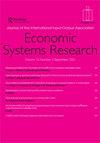A scenario-based method for projecting multi-regional input–output tables
IF 1.6
4区 经济学
Q2 ECONOMICS
引用次数: 5
Abstract
Multi-regional input–output (MRIO) data are a powerful tool to analyze complex interdependencies in the international trade and supply network. Their field of application is however limited by the fact that MRIO datasets are only available for past years whereas the structure of the international trade network has been found to change profoundly over time. We here propose the SPIN method, a simple and flexible algorithm that can project MRIO tables into the future based on transparent scenarios of how gross domestic product and trade relations may evolve in that time. By combining well-established input–output techniques, namely the Leontief quantity model and an RAS-type algorithm, our method provides a straightforward mean to convert quantitative scenarios of the world economy into consistent MRIO tables. We illustrate the functioning of the SPIN method by projecting the evolution of the trade network after the 2008 financial crisis under different alternative scenarios of recovery.一种基于场景的多区域投入产出表投影方法
多区域投入产出(MRIO)数据是分析国际贸易和供应网络中复杂相互依赖关系的有力工具。然而,它们的应用领域受到以下事实的限制:MRIO数据集仅可用于过去几年,而国际贸易网络的结构已被发现随着时间的推移发生了深刻的变化。我们在此提出SPIN方法,这是一种简单而灵活的算法,可以根据国内生产总值和贸易关系在未来如何演变的透明情景,将MRIO表预测到未来。通过结合完善的投入产出技术,即Leontief数量模型和ras型算法,我们的方法提供了一种直接的方法,将世界经济的定量情景转换为一致的MRIO表。我们通过预测2008年金融危机后贸易网络在不同可选复苏情景下的演变来说明SPIN方法的功能。
本文章由计算机程序翻译,如有差异,请以英文原文为准。
求助全文
约1分钟内获得全文
求助全文
来源期刊

Economic Systems Research
ECONOMICS-
CiteScore
5.60
自引率
4.00%
发文量
17
期刊介绍:
Economic Systems Research is a double blind peer-reviewed scientific journal dedicated to the furtherance of theoretical and factual knowledge about economic systems, structures and processes, and their change through time and space, at the subnational, national and international level. The journal contains sensible, matter-of-fact tools and data for modelling, policy analysis, planning and decision making in large economic environments. It promotes understanding in economic thinking and between theoretical schools of East and West, North and South.
 求助内容:
求助内容: 应助结果提醒方式:
应助结果提醒方式:


